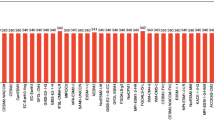Abstract
The climates simulated by 15 coupled atmosphere/ocean climate models participating in the first phase of the Coupled Model Intercomparison Project (CMIP1) are intercompared and evaluated. Results for global means, zonal averages, and geographical distributions of basic climate variables are assembled and compared with observations. The current generation of climate models reproduce the major features of the observed distribution of the basic climate parameters, but there is, nevertheless, a considerable scatter among model results and between simulated and observed values. This is particularly true for oceanic variables. Flux adjusted models generally produce simulated climates which are in better accord with observations than do non-flux adjusted models; however, some non-flux adjusted model results are closer to observations than some flux adjusted model results. Other model differences, such as resolution, do not appear to provide a clear distinction among model results in this generation of models. Many of the systematic differences (those differences common to most models), evident in previous intercomparison studies are exhibited also by the CMIP1 group of models although often with reduced magnitudes. As is characteristic of intercomparison results, different climate variables are simulated with different levels of success by different models and no one model is “best” for all variables. There is some evidence that the “mean model” result, obtained by averaging over the ensemble of models, provides an overall best comparison to observations for climatological mean fields. The model deficiencies identified here do not suggest immediate remedies and the overall success of the models in simulating the behaviour of the complex non-linear climate system apparently depends on the slow improvement in the balance of approximations that characterize a coupled climate model. Of course, the results of this and similar studies provide only an indication, at a particular time, of the current state and the moderate but steady evolution and improvement of coupled climate models.
Similar content being viewed by others
Author information
Authors and Affiliations
Additional information
Received: 26 January 2000 / Accepted: 9 June 2000
Rights and permissions
About this article
Cite this article
Lambert, S., Boer, G. CMIP1 evaluation and intercomparison of coupled climate models. Climate Dynamics 17, 83–106 (2001). https://doi.org/10.1007/PL00013736
Issue Date:
DOI: https://doi.org/10.1007/PL00013736




